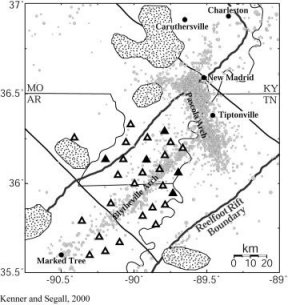When it comes to earthquakes, most of the action occurs at the edges of tectonic plates. As these large blocks of Earth’s crust scrape past each other, they sometimes lock up—until the rocks can no longer stand the stress. When that energy suddenly lets loose, there’s a whole lotta shakin’ going on.

Yet occasionally, major temblors happen far from the edges of any tectonic plate. One such place is the New Madrid Fault Zone, which is named after the small Missouri town that had the misfortune to sit atop what is considered the largest earthquake to strike the continental United States in recorded history. A Stanford University research team recently came up with a mathematical model to explain how such midplate earthquakes might occur.
The legendary temblor, felt as far away as Quebec, was one of a series of earthquakes in late 1811 and early 1812 along the group of faults that define the New Madrid Fault Zone. Similar earthquakes have shaken the area every 500 years or so for at least the past 2 millennia (SN: 6/8/96, p. 362).
Researchers have proposed several general explanations for such midplate earthquakes, but none have mechanically modeled repeated quakes. The new model was developed using techniques similar to those engineers use to analyze stress in manmade structures, says Shelley J. Kenner, a geophysicist now at California Institute of Technology in Pasadena and lead author of the report in the Sept. 29 Science.
In their simulation, the researchers assume that a large zone of rock embedded in the crust beneath a midplate fault begins to weaken. Changes in fluid pressure or heat flow in the rock could be responsible, Kenner says. As this rock becomes less able to resist stress, he says, the forces it had been shouldering shift to the surrounding crust, which triggers earthquakes along the fault.
Results of this simulation match the recent earthquake history of the New Madrid Fault Zone, Kenner notes. The model produced sequences of large earthquakes 500 to 1,000 years apart. Each quake caused opposite sides of the fault to move 5 to 10 meters.
The simulation reproduces another characteristic of midplate faults, the extremely small motion along the fault between major quakes. Global Positioning System measurements of the New Madrid Fault Zone between 1991 and 1997 reveal hardly any movement. Although some scientists believe that this stability indicates the earthquake risk in the area has been overestimated (SN: 12/19&26/98, p. 400), Kenner says that in her model, periods of little motion don’t rule out the occasional large earthquake.
William D. Stuart, a geophysicist with the U.S. Geological Survey in Menlo Park, Calif., says Kenner has devised “a precise, quantitative model that has the happy result of being consistent with observations from the field.”
Five years ago, Stuart notes, scientists had only general ideas about what might cause large midplate earthquakes. He says that Kenner’s model provides a testable hypothesis that may enable researchers to better understand seismic activity in other midplate areas.







